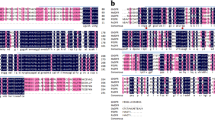Abstract
Flavonoids, in particular the anthocyanins,are responsible for flower colour in manyspecies. The dihydroflavonols represent abranch point in flavonoid biosynthesis,being the intermediates for production ofboth the coloured anthocyanins, through theaction of the enzyme dihydroflavonol4-reductase (DFR), and the colourlessflavonols, produced by flavonol synthase(FLS). In this study the white-flowered,flavonol accumulating Mitchell line ofpetunia was used as a model to examine theinteraction between DFR and FLS enzymeactivities and possibilities forredirecting flavonoid biosynthesis awayfrom production of flavonols and towardsanthocyanins. Introduction of a 35SCaMV-DFR sense transgene construct causedthe production of anthocyanins, resultingin a pink-flowered phenotype. Furthermore,inhibition of FLS production throughintroduction of an FLS antisense RNAconstruct also led to anthocyaninproduction and a pink-flowered phenotype. A combination of both transgenes gave thehighest level of anthocyanin formation. Anthocyanins were produced in the DFR-senseand FLS-antisense transgenic lines in spiteof the greatly reduced levels of geneexpression in the Mitchell line for threeenzymes late in anthocyanin biosynthesis,anthocyanindin synthase, UDP-glucose:flavonoid 3-O-glucosyltransferase andUDP-rhamnose: anthocyanidin-3-glucosiderhamnosyltransferase. Thus, the level ofgene activity required for visibleanthocyanin formation is much lower thanthe high levels normally induced duringpetal development. Altering the balancebetween the DFR and FLS enzyme activities,using genetic modification, may be a usefulstrategy for introducing or increasinganthocyanin production in target ornamentalspecies.
Similar content being viewed by others
References
An, G., P.R. Ebert, A. Mitra & S.B. Ha, 1988. Binary vectors. In: G.B. Gelvin & R.A. Schilperoort (Eds.), Plant Molecular Biology Manual A3, pp. 1-19. Kluwer Academic Publishers, Dordrecht, Belgium.
Ausubel, F.M., K. Bahnse, M. Hanson, A. Mitchell & H.J. Smith, 1980. Cell and tissue culture of haploid and diploid petunia 'Mitchell'. Plant Mol Biol Newsl 1: 26-32.
Beld, M.G.H.M., C. Martin, H. Huits, A.R. Stuitje & A.G.M. Gerats, 1989. Flavonoid synthesis in Petunia hybrida: partial characterization of dihydroflavonol-4-reductase genes. Plant Mol Biol 13: 491-502.
Bloor, S.J., J.M. Bradley, D.H. Lewis & K.M. Davies, 1998. Identification of flavonol and anthocyanin metabolites in leaves of petunia Mitchell and its Lc transgenic. Phytochemistry 49: 1427-1430.
Brouillard, R. & O. Dangles, 1993. Flavonoids and flower colour. In: J.B. Harborne (Ed.), The Flavonoids: Advances in Research since 1986, pp. 565-587. Chapman & Hall, London.
Cornu, A. & E. Farcy, 1981. Genotype of petunia Mitchell line. Plant Mol Biol Newsl 2: 58.
Davies, K.M. & K.E. Schwinn, 1997. Flower colour. In: R.L. Geneve, J.E. Preece & S.A. Merkle (Eds.), Biotechnology of Ornamental Plants, pp. 259-294. Wallingford, U.K., CAB International.
Davies, K., C. Winefield, D. Lewis, K. Nielsen, J.M. Bradley, K. Schwinn, S. Deroles, D. Manson & B. Jordan, 1997. Research into flower colour and flowering time with Eustoma grandiflorum (lisianthus). Flowering Newsl 23: 24-32.
Davies, K.M., S.J. Bloor, G.B. Spiller & S.C. Deroles, 1998. Production of yellow colour in flowers: redirection of flavonoid biosynthesis in Petunia. Plant J 13: 259-266.
Deroles, S.C. & R.C. Gardner, 1988. Expression and inheritance of kanamycin resistance in a large number of transgenic petunias generated by Agrobacterium-mediated transformation. Plant Mol Biol 11: 335-364.
de Vlaming, P., 1981. Genotype determination of Petunia 'Mitchell' with respect to some flower colour genes. Plant Mol Biol Newsl 2: 106.
Elomaa, P. & T. Holton, 1994. Modification of flower colour using genetic engineering. Biotech Genet Eng Rev 12: 63-88.
Gerats, A.G.M., P. de Vlaming, M. Doodeman, B. Al & A.W. Schram, 1982. Genetic control of the conversion of dihydro-flavonols into flavonols and anthocyanins in flowers of Petunia hybrida. Planta 155: 364-368.
Holton, T.A. & E.C. Cornish, 1995. Genetics and biochemistry of anthocyanin biosynthesis. Plant Cell 7: 1071-1083.
Holton, T.A., F. Brugliera & Y. Tanaka, 1993. Cloning and expression of flavonol synthase from Petunia hybrida. Plant J 4: 1003-1010.
Martin, C., A. Prescott, S. Mackay, J. Bartlett & E. Vrijlandt, 1991. Control of anthocyanin biosynthesis in flowers of Antirrhinum majus. Plant J 1: 37-49.
Martin, C. & T. Gerats, 1993a. Control of pigment biosynthesis genes during petal development. Plant Cell 5: 1253-1264.
Martin, C. & T. Gerats, 1993b. The control of flower colouration. In: B.R. Jordan (Ed.), The Molecular Biology of Flowering, pp. 219-255. CAB International, Wallingford.
Mol, J., G. Jenkins, E. Schafer & D. Weiss, 1996. Signal perception, transduction and gene expression involved in anthocyanin biosynthesis. Crit Rev Plant Sci 15: 525-557.
Quattrocchio, F., J.F. Wing, H.T.C. Leppen, J.N.M. Mol & R.E. Koes, 1993. Regulatory genes controlling anthocyanin pigmentation are functionally conserved among plant species and have distinct sets of target genes. Plant Cell 5: 1497-1512.
Quattrocchio, F., J. Wing, K. van der Woude, E. Souer, N. de Vetten, J. Mol & R. Koes, 1999. Molecular analysis of the anthocyanin2 gene of petunia and its role in the evolution of flower color. Plant Cell 11: 1433-1444.
Quattrocchio, F., J.R. Wing, K. van der Woude, J.N.M. Mol & R. Koes, 1998. Analysis of bHLH and MYB domain proteins: species-specific regulatory differences are caused by divergent evolution of target anthocyanin genes. Plant J 13: 475-488.
Rosati, C., A. Cadic, M. Duron, J.P. Renou & P. Simoneau, 1997. Molecular cloning and expression analysis of dihydroflavonol 4-reductase gene in flower-organs of Forsythia × intermedia. Plant Mol Biol 35: 303-311.
Schwinn, K.E., K.M. Davies, S.C. Deroles, K.R. Markham, R.M. Miller, J.M. Bradley, D.G. Manson & N.K. Given, 1997. Expression of an Antirrhinum majus UDP-glucose-flavonoid-3-O-glucosyltransferase transgene alters flavonoid glycosylation and acylation in lisianthus (Eustoma grandiflorum Grise). Plant Sci 125: 53-61.
Wiering, H. & P. de Vlaming, 1984. Inheritance and biochemistry of pigments. In: K.C. Sink (Ed.), Monographs on Theoretical and Applied Genetics 9: Petunia, pp. 49-76. Springer-Verlag, Berlin, Germany.
Author information
Authors and Affiliations
Rights and permissions
About this article
Cite this article
Davies, K.M., Schwinn, K.E., Deroles, S.C. et al. Enhancing anthocyanin production by altering competition for substrate between flavonol synthase and dihydroflavonol 4-reductase. Euphytica 131, 259–268 (2003). https://doi.org/10.1023/A:1024018729349
Issue Date:
DOI: https://doi.org/10.1023/A:1024018729349




